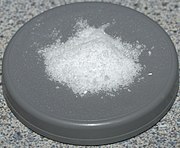TATP
 Cyclic dimer and trimer examples
|
|||
|
|
|||
| Names | |||
|---|---|---|---|
|
IUPAC names
3,3-Dimethyl-1,2-dioxacyclopropane
(monomer) 3,3,6,6-Tetramethyl-1,2,4,5-tetraoxane (dimer) 3,3,6,6,9,9-Hexamethyl-1,2,4, 5,7,8-hexaoxacyclononane (trimer) 3,3,6,6,9,9,12,12-Octamethyl-1,2,4, 5,7,8,10,11-octaoxacyclododecane (tetramer) |
|||
| Other names
Triacetone triperoxide
Peroxyacetone Mother of Satan |
|||
| Identifiers | |||
|
3D model (Jmol)
|
|
||
| ChemSpider | |||
| E number | E929 (glazing agents, ...) | ||
|
PubChem CID
|
|||
|
|||
|
|||
| Properties | |||
| C6H12O4 (dimer) C9H18O6 (trimer) C12H24O8 (tetramer) |
|||
| Molar mass | 148.157 g/mol (dimer) 222.24 g/mol (trimer) |
||
| Appearance | White crystalline solid | ||
| Melting point | 131.5 to 133 °C (dimer) 91 °C (trimer) |
||
| Boiling point | 97 to 160 °C (207 to 320 °F; 370 to 433 K) | ||
| Insoluble | |||
| Hazards | |||
| Main hazards | Explosive | ||
| Explosive data | |||
| Shock sensitivity | High / moderate when wet | ||
| Friction sensitivity | High / moderate when wet | ||
| Detonation velocity | 5300 m/s 17,384 ft/s 3.29 miles per second |
||
| RE factor | 0.83 | ||
|
Except where otherwise noted, data are given for materials in their standard state (at 25 °C [77 °F], 100 kPa).
|
|||
|
|
|||
| Infobox references | |||
Acetone peroxide is an organic peroxide and a primary high explosive. It is produced by the oxidation of acetone to yield a mixture of linear monomer and cyclic dimer, trimer, and tetramer forms. The trimer is known as triacetone triperoxide (TATP) or tri-cyclic acetone peroxide (TCAP). Acetone peroxide takes the form of a white crystalline powder with a distinctive bleach-like odor and can explode if subjected to heat, friction, or shock. As a non-nitrogenous explosive, TATP has historically been more difficult to detect, and it has been implicated as the explosive used in terrorist attacks in Europe (2016 Brussels bombings) in 2016 and earlier.
Acetone peroxide (specifically, triacetone triperoxide) was discovered in 1895 by Richard Wolffenstein. Wolffenstein combined acetone and hydrogen peroxide, and then he allowed the mixture to stand for a week at room temperature, during which time a small quantity of crystals precipitated, which had a melting point of 97 °C. He was the first researcher to receive a patent for using the peroxide as an explosive compound.
In 1899 Adolf von Baeyer and Victor Villiger described the first synthesis of the dimer and described use of acids for the synthesis of both peroxides. Baeyer and Villiger prepared the dimer by combining potassium persulfate in diethyl ether with acetone, under cooling. After separating the ether layer, the product was purified and found to melt at 132–133°C. They found that the trimer could be prepared by adding hydrochloric acid to a chilled mixture of acetone and hydrogen peroxide. By using the depression of freezing points to determine the molecular weights of the compounds, they also determined that the form of acetone peroxide that they had prepared via potassium persulfate was a dimer, whereas the acetone peroxide that had been prepared via hydrochloric acid was a trimer, like Wolffenstein's compound.
...
Wikipedia


